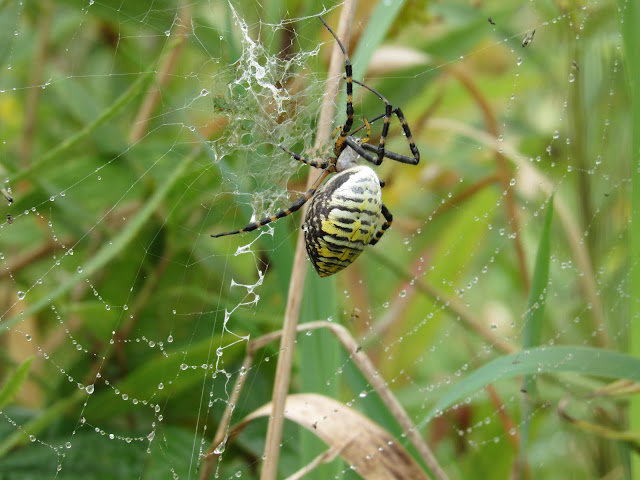Centennial Park
Friday, September 30, 3:00 PM- 5:15 PM
Temperature: 65 degrees Fahrenheit
Weather: Partly cloudy, intermittent slight rain, winds out of northwest (It's funny to me that the weather description of the last field trip works for this one as well.)
My visit to Nipper Wildlife Sanctuary was only two hours after finding my first Sabine's Gull. It was a day of probably excessive birdwatching, to be honest, if such a thing exists. Our first birds here were my first six fall Dark-eyed Juncos (Junco hyemalis). Our second birds were some of the 300 or so American Goldfinches we saw over the course of the field trip. Large flocks of these goldfinches flew out of the grass and landed in the nearby trees. I was constantly looking at the trees and going "Is that a... no, it's a goldfinch." Most of the time, I was right, but at least once, I wasn't.
I did this so often I missed a half-dozen Eurasian Tree Sparrows (Passer montanus). These are quite intersting, as they are native to Eurasia, but were introduced to St. Louis in 1870. They quite liked St. Louis, and live there yet. The descendants of these Eurasian Tree Sparrows went north along the Illinois and Mississippi River valleys. They haven't gotten much further than that, in a hundred and forty-five years of living on this continent. I guess they know what they like.
In addition to all the goldfinches, I saw ten Canada Geese, four Mourning Doves, three Killdeer, one Great Egret, and one Northern Flicker fly past. I also spotted some kind of small wren hiding in the grasses, which I was unable to identify. Searching around the ponds with another member of our expedition, we turned up five or six Cricket Frogs, only one of which I managed to catch. We then found this lovely large spider (Argiope sp.):
After feeding it a grasshopper or two, we moved on to the dead trees in the northern section of the preserve. Here, about fifteen woodpeckers of four different species ( One each of Downy and Red-bellied, nine Red-headed Woodpeckers, and four Yellow-bellied Sapsuckers) had gathered.
Like the juncos, the Yellow-bellied Sapsuckers (Sphyrapicus varius) seemed just a wee bit early, at least according to the birder I was with. We watched about four of them peck away:
It wasn't all woodpeckers, as several Blue Jays, two Common Grackles, two Belted Kingfishers, an Eastern Phoebe, an American Crow, a Black-capped Chickadee, two Grey Catbirds, six European Starlings, and five Red-winged Blackbirds (Agelaius phoeniceus) joined in, as well as more American Goldfinches and some unknown sparrows. There were LOTS of birds!
Walking back from this bird-filled corner of the preserve, we went to a place where there was once a trail, and where we thought there was a trail. It vanished, however, and we walked on regardless, through the regrowing grasses. Just after finding a trail again, we discovered these False Indigo seedpods covered with these small bugs. Anyone know what they are?
Crossing over the road to the south side of the preserve, we scared a small rabbit, and I spotted these two Northern Flickers (Colaptes auratus) in one of the dead trees, as well as some other bird too far-off to identify. It began to mist again, only to let up once more.
Walking along, we stumbled upon this Milkweed Tussock Moth (Euchaetes egle) caterpillar on a milkweed leaf. While it's no Monarch , these are wild-looking.
Far in front of us, we could see a Cooper's Hawk (Accipter cooperii), which vanished into the unknown as we approached. I mean this quite literally, as none of us saw it leave its perch, and yet it was gone. I always wonder how much wildlife does this, and we do not realize it. I suppose that biodiversity is like an iceberg, where only 10% is visible on the surface. I remember once sitting on a rock in Rochester Park when I was younger, while all the rest of the children played in the playground. I sat there for several minutes, and during this time, a small field mouse emerged, and scurried from one burrow to the next. Field mice are seemingly everywhere, but no one sees them because they are aware of us and excellent at hiding. What else is out there, hiding, too?
We looked east, and we saw horses (and one donkey, visible only by its ears in this photo) running through the prairie. We assume the truck in the back is someone trying to heard them back after they escaped. Later, they were seen browsing on the next-door neighbor's yard.
It feels so good to be getting back into blog writing! The schedule for the next few weeks will be very irregular, so be prepared for that. Some weeks there could be two or three blogposts, and the next week there could be none. I'm at least three blogposts behind still. That won't be changing for the immediate future. I've seen at least three new bird species, a native orchid, and a heck of a lot of other stuff to look forward to soon!
http://ebird.org/ebird/view/checklist/S31830683
















No comments:
Post a Comment